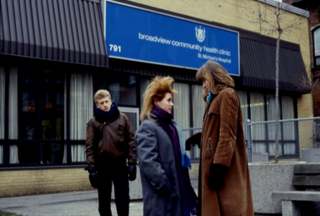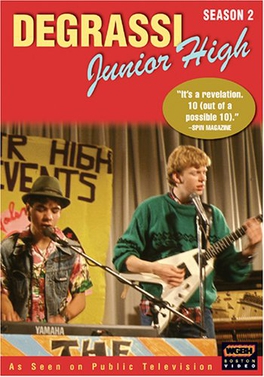
Degrassi Junior High is a Canadian television series created by Kit Hood and Linda Schuyler. The second series in the Degrassi franchise and the first to be set in a universe that has spanned multiple decades, it aired on the CBC from 18 January 1987 to 27 February 1989, and on PBS in the United States starting from September 1987. A non-union show, it was primarily produced by Playing With Time with involvement from WGBH. Although not generally acknowledged by the mainstream, it has been frequently referred to as a pioneer of the teen drama genre that prefigured later and better-known series such as Beverly Hills, 90210 and Dawson's Creek.

Degrassi: The Next Generation is a Canadian teen drama television series created by Yan Moore and Linda Schuyler. It is the fourth series in the Degrassi franchise and a revival of Degrassi Junior High and Degrassi High. It premiered on CTV on October 14, 2001, and concluded on August 2, 2015, on MTV Canada. The series centers around a new ensemble cast of students at the fictional Degrassi Community School who face challenges such as sex, teen pregnancy, bullying, date rape, drug abuse, body image, homosexuality, domestic violence, gang violence, self-injury, suicide, abortion, mental disorders and many other issues. Various characters from the previous two series also returned as adults in recurring or guest roles.

Degrassi is a Canadian teen drama television franchise created by Kit Hood and Linda Schuyler. Spanning five main series from 1979 to 2017, it follows the lives of youths in Toronto. With the exception of the first series, the franchise takes place in the same fictional timeline, with the titular school as the central setting. Outside of television, the franchise comprises companion novels, graphic novels, documentaries, soundtracks, and non-fiction works.

The Kids of Degrassi Street is a Canadian children's television series created by Kit Hood and Linda Schuyler. The first entry in the Degrassi franchise and the only one to focus on children instead of teenagers, it follows the lives of a group of children living on De Grassi Street in Toronto. It was produced by Hood and Schuyler's independent company Playing With Time. The series originated as a collection of annual standalone short films that started with Ida Makes a Movie, a live-action adaptation of the Kay Chorao book which premiered on the CBC on December 8, 1979. It became a full series in 1982 when the CBC ordered five more episodes.

Degrassi Talks is a Canadian non-fiction documentary television miniseries and part of the Degrassi franchise created by Linda Schuyler and Kit Hood. Running six episodes from February 29 to March 30, 1992, it featured actors from Degrassi Junior High and Degrassi High taking the role of journalists and conducting interviews with other teenagers and young adults across Canada on various topics addressed by the series such as abuse, substance addiction, homophobia, and teenage pregnancy. It combined candid and man-on-the-street interviews as well as relevant archive footage from the television series and on-screen statistics. Each episode was hosted by an actor whose character had some relation to the focused subject.

Linda Schuyler is a Canadian television producer. She is best known for being the co-creator and producer of the Degrassi franchise, which has spanned five series over four decades. She is a co-founder of Playing With Time, Inc., and Epitome Pictures, the production companies involved with the franchise over its 40-year-long history respectively.

School's Out is a Canadian drama television film based on the Degrassi teen drama franchise created by Linda Schuyler and Kit Hood in 1979. It was directed by Hood and written by Yan Moore, based on a story by Moore, Schuyler and Hood. It aired on CBC Television on January 5, 1992, and served as a finale to the series Degrassi High and its predecessor Degrassi Junior High, which are collectively known as the Degrassi Classic era of the franchise.

Christopher Hood, known professionally as Kit Hood, was a Canadian director, editor, writer, and producer who is best known for being the co-creator of the Degrassi television franchise. He was the co-creator and a major creative force of the first three series of the franchise, The Kids of Degrassi Street (1979–86), Degrassi Junior High (1987–89), and Degrassi High (1989-91). As a director, Hood won a Gemini Award in 1987 for the Degrassi Junior High episode "It's Late".

Derek Wheeler is a fictional character from the Degrassi teen drama franchise. He was portrayed by Neil Hope. He appears throughout Degrassi Junior High and Degrassi High, with two cameo appearances in Degrassi: The Next Generation. His role throughout the former two series primarily concerns his friendship with Joey Jeremiah and Archie "Snake" Simpson, and later the death of his adoptive parents in a traffic collision with a drunk driver. Throughout the series, he plays with Joey and Snake in a band called The Zit Remedy, who are always seen performing one song.

Christine "Spike" Nelson is a fictional character from the Degrassi teen drama franchise. Portrayed by Amanda Stepto, Spike appeared throughout Degrassi Junior High (1987–89), Degrassi High (1989–91), and the first nine seasons of Degrassi: The Next Generation (2001–10). Starting as an unnamed extra before being given a name and storyline, Spike's character largely revolves around her teenage pregnancy and motherhood.

Epitome Pictures Inc. was a Canadian film and television production company based in Toronto, Ontario. Founded by Linda Schuyler and Stephen Stohn in 1992, the company is best known for producing Degrassi: The Next Generation and Degrassi: Next Class, the fourth and fifth respective entries of the Degrassi teen drama franchise, of which was co-created by Schuyler. Other television series produced by Epitome include Liberty Street,Riverdale, and The L.A. Complex. In 2016, Epitome was absorbed into DHX Media and the Epitome name and branding ceased.
"Mother and Child Reunion" is the two-part pilot episode of the Canadian teen drama television series Degrassi: The Next Generation, which premiered on October 14, 2001 on the CTV Television Network. The episode was written by story editor Aaron Martin and series co-creator/creative consultant Yan Moore, and directed by Bruce McDonald. As with the majority of Degrassi: The Next Generation episodes, "Mother and Child Reunion" takes its title from a pop song, "Mother and Child Reunion", written and performed by Paul Simon.

"It's Late" is the 11th episode of the first season of Canadian teen drama television series Degrassi Junior High. It originally aired on the CBC in Canada on April 5, 1987. After a careless night with Shane at a classmate's party, Spike fears she is pregnant. Meanwhile, Arthur gives continuously bad romantic advice to his friend Yick.

"A New Start" is the two-part premiere episode of the Canadian teen drama series Degrassi High. It aired on CBC in its hour-long form on 6 November 1989, and on PBS in the United States on 13 January 1990. The episode was written by Yan Moore and directed by Kit Hood. It is the first of three episodes of Degrassi that depict abortion, followed by 2003's "Accidents Will Happen" from Degrassi: The Next Generation and 2017's "#IRegretNothing" from Degrassi: Next Class.

The first season of Degrassi Junior High, a Canadian teen drama television series, aired in Canada from January 18, 1987, to May 3, 1987, consisting of thirteen episodes. The series follows the lives of a group of seventh and eighth grade school children attending the titular school as they face various issues and challenges such as child abuse, homophobia, teenage pregnancy, and body image. Filming for the season began on 8–10 July 1986 in Etobicoke, Ontario and wrapped in the winter of 1986.

The second season of Degrassi Junior High, a Canadian teen drama television series, aired in Canada from January 4, 1988, to April 18, 1988, consisting of thirteen episodes. The series follows the lives of a group of seventh and eighth grade school children attending the titular school as they face various issues and challenges such as child abuse, homophobia, teenage pregnancy, and body image.
"Bye-Bye, Junior High" is the sixteenth episode of the third and final season of Canadian teen drama television series Degrassi Junior High. It originally aired on CBC Television in Canada on February 27, 1989. It was written by Yan Moore and directed by Kit Hood. The episode takes place at the end of the school year as graduation approaches; despite the fallout from the death of his parents at the beginning of the season, Derek "Wheels" Wheeler manages to pass, but Christine "Spike" Nelson, who is raising her daughter Emma, must make up for poor grades over the holidays, something which she does not react well to. At the graduation dance, a fault in the boiler room causes a fire to spread throughout the school, razing it to the ground.

Playing With Time, Inc. was a Canadian independent film and television production company based in Toronto, Ontario. Founded by Linda Schuyler and Kit Hood in 1976, it is best known for being the original production company for the Degrassi television franchise, producing The Kids of Degrassi Street (1979–86), Degrassi Junior High (1987–89), and Degrassi High (1989–91). It also produced educational short films throughout its existence. The company's work was known for its unconventional filmmaking practices, including casting ordinary people in lieu of experienced trained actors. Schuyler founded Epitome Pictures in 1992, leaving Hood in sole control of the company. By 1998, it was dormant.

















